

Mythology. Earth Diver Myth. Creation myths develop in oral traditions and therefore typically have multiple versions[3] and are the most common form of myth, found throughout human culture.[6] Definitions[edit] In Daoist creation myth, "The Way gave birth to unity; unity gave birth to duality; duality gave birth to trinity; trinity gave birth to the myriad creatures.
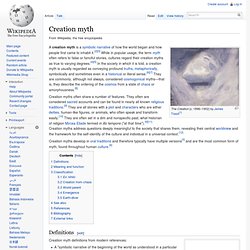
" (Daodejing, 4th century BCE)[13] Creation myth definitions from modern references: A "symbolic narrative of the beginning of the world as understood in a particular tradition and community. Religion professor Mircea Eliade defined the word myth in terms of creation: Myth narrates a sacred history; it relates an event that took place in primordial Time, the fabled time of the "beginnings. " Meaning and function[edit] All creation myths are in one sense etiological because they attempt to explain how the world was formed and where humanity came from.[18] Ethnologists and anthropologists[which?]
Each beginning seems to presuppose an earlier beginning. ... Misc about Myths & Deities - Myths or Fables. Therion (Thelema) Aleister Crowley. Triple deity. Triple Goddess (Neopaganism)
Venus figurines. "Venus figurines" is an umbrella term for a number of prehistoric statuettes of women portrayed with similar physical attributes from the Upper Palaeolithic, mostly found in Europe, but with finds as far east as Irkutsk Oblast, Siberia, extending their distribution to much of Eurasia, from the Pyrenees to Lake Baikal.

Terra (Roman mythology) The word tellus, telluris is also a Latin common noun for "land, territory; earth," as is terra, "earth, ground".

In literary uses, particularly in poetry, it may be ambiguous as to whether the goddess, a personification, or the common noun is meant. This article preserves the usage of the ancient sources regarding Tellus or Terra. Dedicatory inscription to Terra Mater fulfilling a vow (votum), 1st century AD The two words terra and tellus are thought to derive from the formulaic phrase tersa tellus, meaning "dry land". [citation needed] The etymology of tellus is uncertain; it is perhaps related to Sanskrit talam, "plain ground The 4th-century AD Latin commentator Servius distinguishes between tellus and terra in usage.
Varro identifies Terra Mater with Ceres: Mother Earth. Mother Earth may refer to:

Pachamama (fertility goddess, Andes) Pachamama is a goddess revered by the indigenous people of the Andes.
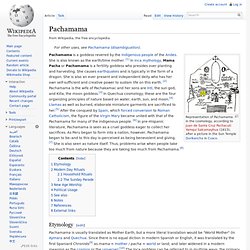
Vergin (United w/ Pachamama after Spanish Invasion) Roman Catholic veneration of Mary, the mother of Jesus, which has grown over time in importance, is manifested not only in prayer but also in the visual arts, poetry and music.[2][3][4][5] Popes have encouraged it, while also taking steps to reform some manifestations of it.
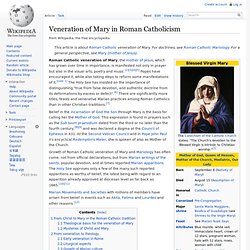
[note 1] The Holy See has insisted on the importance of distinguishing "true from false devotion, and authentic doctrine from its deformations by excess or defect".[6] There are significantly more titles, feasts and venerative Marian practices among Roman Catholics than in other Christian traditions.[7] Marian Movements and Societies with millions of members have arisen from belief in events such as Akita, Fatima and Lourdes and other reasons.[12] From Christ to Mary in the Roman Catholic tradition[edit] Mat Zemlya. Mother goddess. Mother goddess. Mother Nature. Mat Zemlya. Slavic mythology. Many generations of Slavic artists were inspired by their national folklore: Ilya Yefimovich Repin, Sadko in the Underwater Kingdom (1876) Slavic mythology is the mythological aspect of the polytheistic religion that was practised by the Slavs before Christianisation.

The religion possesses many common traits with other religions descended from the Proto-Indo-European religion. Old Slavic religion evolved over more than a thousand years and some parts of it were from neolithic or possibly even mesolithic times. Gaia (Greek Mythology) The Greek word γαῖα (transliterated as gaia) is a collateral form of γῆ[4] (gē, Doric γᾶ ga and probably δᾶ da)[5] meaning Earth,[6] a word of uncertain origin.[7] R.
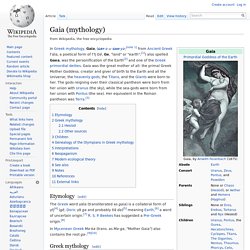
S. P. Beekes has suggested a Pre-Greek origin.[8] In Mycenean Greek Ma-ka (trans. as Ma-ga, "Mother Gaia") also contains the root ga-.[9][10] According to Hesiod, Gaia conceived further offspring with Uranus, first the giant one-eyed Cyclopes: Brontes ("Thunder"), Steropes ("Lightning") and Arges ("Bright");[16] then the Hecatonchires: Cottus, Briareos and Gyges, each with a hundred arms and fifty heads.[17] As each of the Cyclopes and Hecatonchires were born, Uranus hid them in a secret place within Gaia, causing her great pain.
Because Cronus had learned from Gaia and Uranus, that he was destined to be overthrown by his own child, Cronus swallowed each of the children born to him by his Titan sister Rhea. Gaia hypothesis. The study of planetary habitability is partly based upon extrapolation from knowledge of the Earth's conditions, as the Earth is the only planet currently known to harbour life The Gaia hypothesis, also known as Gaia theory or Gaia principle, proposes that organisms interact with their inorganic surroundings on Earth to form a self-regulating, complex system that contributes to maintaining the conditions for life on the planet.
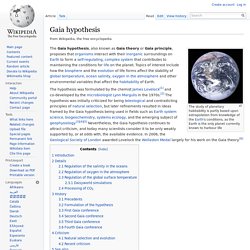
Isis (God of nature and magic,Ideal mother and wife as well as the patroness of ) Temple of Isis in Philae, Egypt Isis (Ancient Greek: Ἶσις, original Egyptian pronunciation more likely "Aset" or "Iset") is a goddess in Ancient Egyptian religious beliefs, whose worship spread throughout the Greco-Roman world.
